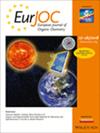General and Anti‐Markovnikov Selective Ni‐Catalyzed Alkylation of Arenes and Heteroarenes with Non‐Activated Olefins
IF 2.7
3区 化学
Q2 CHEMISTRY, ORGANIC
引用次数: 0
Abstract
The majority of C–C coupling reactions between arenes and olefins result in the formation of branched isomer products, exhibiting what is known as Markovnikov selectivity. However, alternative catalytic strategies are required to modulate this selectivity, thereby yielding linear isomer products that are crucial for various significant applications. In this study, a straightforward Ni芳烃和杂芳烃与非活化烯烃的一般和反马尔可夫尼科夫选择性Ni催化烷基化反应
芳烃和烯烃之间的大多数C-C偶联反应导致支链异构体产物的形成,表现出所谓的马尔可夫尼科夫选择性。然而,需要替代的催化策略来调节这种选择性,从而产生对各种重要应用至关重要的线性异构体产品。在这项研究中,提出了一种直接的Ni0-N杂环碳(NHC)催化剂,用于非活化烯烃与芳烃(苯)和杂芳烃(吡啶,吲哚和咪唑吡啶衍生物)的反Markovnikov氢芳化反应。活性催化剂是由NHC配体和稳定的NiII盐原位生成的,NiII盐被碱性氢化物还原(NaH, LiH)。这种策略绕过了合成和分离Ni0-NHC配合物的复杂程序。对烯烃和(杂)芳烃之间的15种反应进行了评价,结果表明,线性异构体的形成是主要产物,其产率从中等到优异和特殊选择性不等。
本文章由计算机程序翻译,如有差异,请以英文原文为准。
求助全文
约1分钟内获得全文
求助全文
来源期刊
CiteScore
5.40
自引率
3.60%
发文量
752
审稿时长
1 months
期刊介绍:
The European Journal of Organic Chemistry (2019 ISI Impact Factor 2.889) publishes Full Papers, Communications, and Minireviews from the entire spectrum of synthetic organic, bioorganic and physical-organic chemistry. It is published on behalf of Chemistry Europe, an association of 16 European chemical societies.
The following journals have been merged to form two leading journals, the European Journal of Organic Chemistry and the European Journal of Inorganic Chemistry:
Liebigs Annalen
Bulletin des Sociétés Chimiques Belges
Bulletin de la Société Chimique de France
Gazzetta Chimica Italiana
Recueil des Travaux Chimiques des Pays-Bas
Anales de Química
Chimika Chronika
Revista Portuguesa de Química
ACH—Models in Chemistry
Polish Journal of Chemistry.

 求助内容:
求助内容: 应助结果提醒方式:
应助结果提醒方式:


